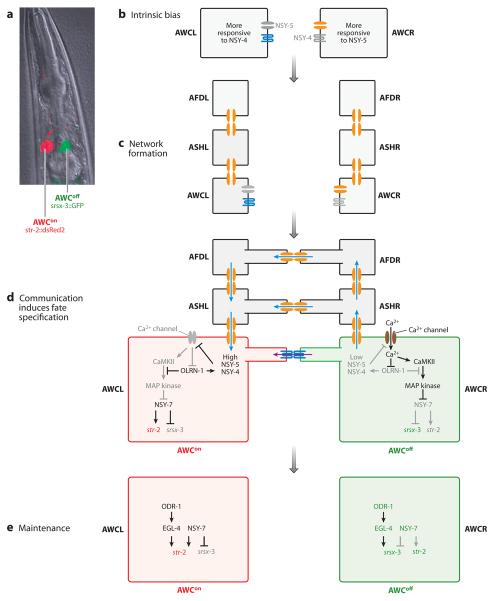Figure 7.
A gap junction–mediated mechanism of lateral inhibition controls stochastic lateral olfactory neuronal fate in worms. (a) The AWC on the left side (AWCL) and the AWC on the right side (AWCR) stochastically and exclusively choose the AWCon or AWCoff fate. AWCon is marked by expression of str-2::dsRed2 whereas AWCoff is marked by expression of srsx-3::green fluorescent protein (GFP). Image from Lesch et al. (2009). (b) AWCL is intrinsically biased to be more responsive to NSY-4 activity whereas AWCR is intrinsically biased to be more responsive to NSY-5 activity. Both cells pursue AWCon fate but via different mechanisms. (c) A gap junction network mediated by NSY-5 forms between ipsilateral AFD, ASH, and AWC neurons in embryonic stages. (d) The network is completed when bilateral neuronal pairs create gap junctions. The AWC pair generates gap junctions via the NSY-5 innexin protein. Signaling through gap junctions is stochastically directed to an AWC cell (e.g., AWCL). Directionality of signaling is reinforced by upregulation of NSY-4 and NSY-5, which represses Ca2+ influx and prevents activation of the MAP kinase (MAPK) cascade. NSY-7 is active in the absence of MAPK activity, which leads to AWCon fate (red). The cell with lower NSY-4 and NSY-5 activity allows Ca2+ influx. Ca2+ activates CAMKII and the MAPK cascade. The MAPK pathway represses NSY-7, which leads to AWCoff fate (green). (e)AWCon fate is maintained by NSY-7. ODR-1 and EGL-4 are generally required for maintenance of both AWCon and AWCoff fates.

